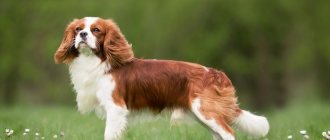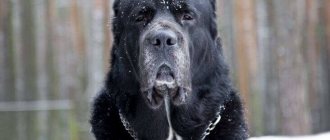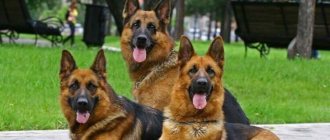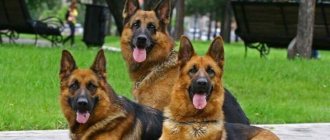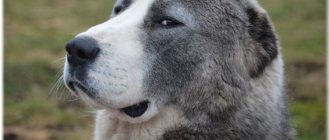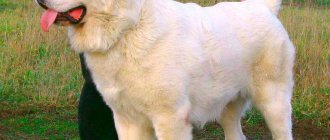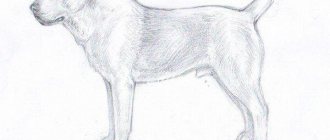Powerful, stately, selflessly devoted to its owners, the Asian Shepherd is a real dream for many dog lovers. But is it so easy to get along with such a pet in everyday life? You should answer this question in advance, since the Alabai breed, or in other words the Central Asian Shepherd Dog, has a unique character. Today's review will tell you everything a responsible owner needs to know.
History of the Alabai breed
Experts believe that the age of the Alabai breed is from 3 to 6 thousand years. This is one of the most ancient dogs that have retained their original appearance to this day. Confirmation can be provided by a terracotta figurine found during excavations of a Bronze Age settlement and dating back to approximately 2000 BC. e. Interestingly, the dog’s tail and ears are cropped.
Alabai puppy
The differences in the names - Turkmen Alabai, Kazakh wolfhound - are due to the fact that the breed was originally formed over a fairly vast territory - from the Caspian Sea and the Southern Urals in the west and north to the foothills of the Dzungarian Alatau and Pamirs in the east and south, where several states are located today. From a geographical point of view, the most accurate name would be “Central Asian Shepherd Dog”, under which the breed is registered.
Descendants of ancient Molossians and Great Danes, Alabais were originally bred for herding and guard work. Nomadic tribes needed a dog that would have enormous strength, fearlessness, endurance and unpretentiousness. All these features were embodied in a gigantic animal with graceful, almost cat-like movements and a proud look.
The spread of Alabais outside Central Asia began approximately in the 30s of the last century, and professional breeding of the breed in kennel clubs started even later. Maybe this is for the better - man simply did not have enough time to spoil what was inherent in this amazing dog through thousands of years of natural selection.
In the summer of 1990, the State Agricultural Industry of the Turkmen SSR approved the breed standard “Turkmen Alabai”. On the territory of the Russian Federation, FCI standard No. 335, published in January 1989, is applied. According to this classification, the breed is called “Central Asian Shepherd Dog”. Since then, no changes have been made to the standard. The purebred Turkmen wolfhound is recognized as a national treasure of Turkmenistan (along with Akhal-Teke horses) and is prohibited from being exported from the country.
Alabai
Mating
Alabaev breeding should occur on the third heat. Before it, 1.5 months before, it is necessary to have your pet examined by a veterinarian, pass the necessary tests and get vaccinations if they were not done in a timely manner.
also important to choose the right partner, who should also be examined at the clinic . If you want to get healthy offspring, then both parents must be healthy and not have any pathologies or abnormalities.
There is no need to feed the animals before the process itself, you can only supply water. Mating should take place on the male’s territory, where he will feel confident. Mating should occur on the 10-14th day of estrus.
In order for the mating to end successfully, certain rules must be followed.:
- If this is the first mating for a female, then she needs a more experienced partner.
- The most favorable time for this process is the first half of the day.
- Don't expect the dogs to attack each other right away; they need about half an hour to get to know each other.
- If the mating is manual, then the owner of the male dog must help him get attached to the bitch.
- You cannot interrupt the animal lock; it can last differently - from five minutes to half an hour.
- In order for conception to occur with the greatest probability, the dogs must mate again after two days.
Appearance of the Central Asian Shepherd
Impressive size, strong constitution and thick coat are the key characteristics of the Alabai’s exterior.
Height
The height at the withers of a male is at least 70 cm, of a female - 65 cm. More significant growth is encouraged while maintaining a harmonious build.
Weight
An adult Alabai male weighs from 50 kg, a female – from 40 kg.
Head
Alabai muzzle
Massive in proportion to the overall texture of the body, the shape of the head (side and top views) is close to rectangular. The skull is flat, long, with a well-developed occipital protuberance. Stop – moderate.
Muzzle
Blunt, medium length, almost not tapering towards the nose. The back is usually straight, although a slight hump is allowed. The chin is well defined. The nose is large, but does not protrude beyond the general contour of the head. The color of the lobe is black; in white and fawn Alabais it can be lightened. Lips preferably have black pigmentation; the upper lip covers the lower jaw with closed teeth. The jaws are wide and strong, the teeth are white, even, and the bite is scissor-shaped.
Eyes
Alabai's eyes are oval-shaped and medium in size. Widely spaced. Color – from light to dark brown. The eyelids, regardless of color, are always black.
Ears
Low set, triangular in shape, hanging. Ears are cropped in the countries of origin or where the law does not prohibit this.
Neck
The Alabai neck is of medium length and muscular. As a special feature of the Central Asian Shepherd Dog, the dewlap stands out.
Back
Adult male Alabai
Straight, wide, with well-developed muscles. The loin is short, slightly convex, powerful.
Breast
Deep, wide and quite long, widening towards the back. The lower part of the chest is lowered to the level of the elbows, and sometimes lower.
Tail
The tail of the Alabai is set high and quite thick at the base. Before docking, it is crescent-shaped. Sometimes in the last third of the length it can be rolled into a ring. Both options are equally acceptable - a docked or natural tail.
Front legs
Straight, parallel. The backbone is strong.
hind legs
Straight, parallel with strong bones. Set slightly wider than the front ones.
Paws
Large, round, collected in a lump. Claw color - any.
Wool
The Alabai has coarse, straight and thick fur. The undercoat is well developed. There are short-haired Alabais (hair length 3-5 cm) and dogs with longer hair (5-7 cm). Asians of the second type are characterized by a small mane on the neck, feathering behind the ears, on the limbs and tail.
Color
Any except blue, brown and black.
Faults, defects and disqualifying characteristics are determined by experts depending on the severity and severity of certain deviations from the CAO breed standard.
Photo
Next in the photo you can see what adult alobayas look like with white, black and other colors.
Character of Alabai
The type of higher nervous activity of the Alabai can be classified as balanced and calm. The balance of mental processes is manifested in the following behavioral reactions: dogs are calm and not subject to fussiness. Compared to males, the psyche of females is more dynamic.
The President of Turkmenistan presented Putin with an alabai
The character of the Alabai is self-possessed, proud and independent. The dog is distinguished by self-confidence and even some mystery. In relation to strangers, the animal behaves distrustfully and warily, at the same time showing amazing sensitivity to the mood of the owner. The way of life of the ancestors did not leave the imprint of simplicity and rudeness on the behavior of the Alabai; this dog is rather characterized by a serious attitude to life with a touch of slight arrogance.
The Central Asian Shepherd is prone to rapid social adaptation and will easily find its place in a human family. The attitude of the Alabai towards other members of the “pack” can be described as peaceful. They also react calmly to pets living with them under the same roof. Asians treat children very well, and the difference between “friend and foe” in this case is not taken into account by the dog.
A true Central Asian Shepherd dog will restrainedly show its distrust of a stranger - it will give vent to its protective instincts only in case of obvious provocation from a stranger. The active defensive reaction of the Alabai has its own characteristics. He will very jealously guard the territory, showing aggression only if the border he has established is violated. In the “neutral zone” the dog will react to other animals or strangers rather with arrogant indifference.
Alabais usually behave calmly during walks, not wasting time on trifles and not reacting to loudly barking mosquitoes, although a strong leash is still necessary when walking the dog in crowded places.
Gender differences are manifested not only in the appearance of dogs, but also in their behavior. A male dog attacks a stranger when trying to trespass without any warning; a female dog attacks as a last resort, trying to solve the problem by barking warningly and blocking the road.
An interesting fact is that the nomads of Central Asia immediately rejected and shot dogs that showed unjustified aggression towards humans, so if, when buying an Alabai, you want to get an angry dog, then you are on the wrong track. Anger as a character trait in a true Asian is absent at the genetic level. To cripple the psyche of this magnificent dog, trying to raise an evil monster out of him, is simply a crime.
If you want to have a reliable security guard and an unspoiled friend in your home, then Alabai is the best choice!
National Kyrgyz Greyhound Taigan
The taigan is a rare species on the verge of extinction. The Kyrgyz Greyhound was bred through selective breeding; its appearance is partly similar to the Kazakh Tazy. In Kyrgyzstan, the Taigan is the only recognized independent breed.
The Kyrgyz Greyhound is famous for its excellent sense of smell, its ability to track prey, it is an ideal hunter in mountainous areas, and a reliable guard of the owner’s house from uninvited guests. He has no equal in the cross-country race, “the Taigan is running - blood is gushing from his ears,” the Kyrgyz say:
- Taigans have a racing, fit type;
- The chest is voluminous and deep, which allows it to withstand heavy physical exertion;
- Legs - high, adapted for high-speed running;
- The tail is saber-shaped;
- The coat is thin and elongated.
Their character is calm, but they will have to put in a lot of effort to achieve results due to the willfulness of the animal.
They have a sharp mind and a calm character, which cannot be said judging by their large size.
Education and training
Owners of Central Asian Shepherds must clearly understand that training and proper education for such a strong animal, which also exhibits pronounced defensive reactions, are necessary by definition.
Another important principle is systematic training. They should be carried out daily and last at least 20-30 minutes. It is very good if the process takes place with the participation of all members of the owner’s family. By the age of seven months, your pet should follow the basic simplest commands: “Come to me!”, “Sit!”, “Place!”, “Ugh!” and so on.
It should be remembered that Alabai is quite capricious and is unlikely to immediately obey you. You can achieve results only by showing a fair amount of patience and finding ways to interest your Asian in the learning process.
Don't forget to reward your big friend for the correct execution of the command, and simply for good behavior. A tidbit, a friendly stroking of the neck, an affectionate kind word will be a good incentive for your pet. One should treat with understanding and patience such character traits of the Alabai as the desire to independently understand the world around him, curiosity, and excessive persistence in achieving a goal (which is often known only to him).
As an Asian grows up, he becomes very attached to his “pack” and to his place of residence, which is typical for guard-type dogs. You should carefully monitor your shepherd's behavior towards strangers. When communicating with “your own”, you should also not allow much familiarity. Stop your dog from pouncing on people in your household. While Alabai is a puppy, it still looks funny, but standing on his feet when an adult dog begins to show his feelings in this way is already problematic.
As for gender differences in relation to the training process, males learn much easier. Girls are much more subtle and cunning; they have much more tricks in their arsenal to avoid obeying the “teacher.”
A lot depends on the quality of training an Alabai puppy, so you can only trust this important process to professionals. Only a competent specialist can turn a clumsy plush puppy into a real guard dog, realizing the main purpose of the Central Asian Shepherd Dog.
Alabai puppies
Basic moments
- Alabai is by no means a fighting dog, although his participation in this cruel entertainment, unfortunately, takes place. And firstly, and secondly, and thirdly, this animal is a guard and protector.
- This dog is characterized by independence in almost all behavioral reactions. He will never act for a “piece of bread”, but rather accept food as a reward for faithful service.
- Absolutely fearless, the Alabai is not inclined to be the first to show aggression and attack unnecessarily. But if warning barks and growls are ignored, and the stranger is deliberately provoking, then the dog’s actions will be very decisive.
- Somewhat capricious by nature, an Asian will never mindlessly carry out commands, and only after assessing the appropriateness of certain actions will he carry them out.
- This dog has a very strong character, so you need to start training it from a very early age. Alabai is very touchy - never hit or humiliate him.
- The best way to a pet's heart is through understanding and mutual respect.
- It is better to entrust the training of the Alabai to a professional. Gaps in the education of such a “serious” dog are extremely undesirable.
- Representatives of the breed are unpretentious, but they really value cleanliness and require a properly balanced diet.
- A sufficient amount of physical activity is necessary to constantly maintain Alabais in good tone.
Care and maintenance
Alabaev cannot be classified as a spoiled breed of dog. Their ancestors lived in very difficult conditions and passed on their unpretentiousness to today's Asians. But this does not mean at all that the owner does not need to organize proper care for his pet.
This large dog is not well suited for living in a city apartment; the best option would be to live on the territory of your country house, where you can arrange a spacious fenced enclosure with a booth for keeping the dog. This applies more to an older dog, and it is advisable to keep the Alabai baby in the house at first, giving him a place away from heating appliances and windows. The puppy should have the opportunity to rest peacefully, away from the hustle and bustle of home. A stronger, matured dog can be transferred to a permanent place of residence in an enclosure. If you are a typical city dweller, then remember the need to walk your pet twice a day, and the duration of each exercise should be at least two hours. While the Alabai may not be on a leash in the enclosure, then for walks you will definitely need a leash (preferably made of tarpaulin tape) and a muzzle.
It is necessary to systematically examine the animal's mouth, ears and eyes. Alabai's eyes can be washed with cotton wool soaked in strong tea leaves, and it is better to treat the ears with special products applied to a cotton swab. Do not use ear sticks under any circumstances!
These dogs are bathed once a month or less, and after washing the pet should be dried thoroughly.
Coat care consists of systematic combing, it is especially important not to forget about this during active spring molting.
Alabais love cleanliness very much, so do not forget to wash the bedding at least a couple of times a month, but you can vacuum it or shake it out thoroughly every day.
Feeding such a large dog has its own characteristics: up to two-thirds of the diet should be meat. It should be lean (beef, veal) and always fresh. If there are problems with the preparation of fresh meat, it is permissible to use high-quality ready-made feed. Your pet's size and lifestyle will influence your menu choices. You cannot feed Alabai with dry mixtures for small breeds of dogs.
Pickles, sweets, flour dishes, spices, and long bones of poultry are contraindicated for the Central Asian Shepherd Dog. Porridge (preferably buckwheat, rice or oatmeal), low-fat sea fish, fresh vegetables and fruits, eggs, and low-fat dairy products are welcome in the diet.
A balanced diet, which must contain the required amount of vitamins and microelements, and a sufficient (but in no case excessive) amount of food, are the main rules for organizing the feeding of Alabai. Clean water should be available to the dog at all times.
Proper care is the key to your pet's good condition.
Sagi Dahmardak
Sagi Dakhmardak is a subspecies of Central Asians, a relative of the Uzbek one, only bred in Tajikistan. This breed is called “Asians” by non-indigenous residents of the republic. The breed received its name from the ancient Tajik language that Sagi Dakhmardak means “man with ten powers.”
These Asians are the best shepherds in the world, loyal friends. In the mountainous regions of the republic it is not even customary to tie them. Sagas are free dogs and perform their duty with dignity without unnecessary commands.
Going far into the mountains in search of better pastures, the dog always follows its owner, understanding his commands perfectly: to turn around or bring up the herd, to return to bring the lagging lamb. With the herd settled, the saga goes to bed; he can sleep the whole sunny day.
If there is a shadow, it will lie there, but if there is no shadow, the Asian will instinctively dig a large hole to get to the wet ground and lie down on the side. This breed is sometimes jokingly called “earth dogs” in Tajikistan.
It's still not worth teasing them. Despite its large size and weight, the sagi runs quickly. The dog is even able to catch up and kill a wolf that threatens the herd with its appearance on the horizon. As a result, these shepherd dogs are known throughout the world as “wolfhounds.” Sagas Dakhmardak are fearless, obedient, loyal, they are the pride of Tajikistan!
Health and diseases of Alabai
Being a descendant of dogs that have accompanied nomadic tribes in Central Asia since time immemorial, Alabai inherited good health and good immunity to various diseases.
But this does not mean that your pet is absolutely immune from health problems. Some of them may be due to genetic problems, and some are a consequence of improper maintenance. As with all large dogs, diseases of the musculoskeletal system come first. The large weight of the animal leads to increased stress, which is associated with a high risk of dysplasia of the hip and knee joints. Walking for a limited time can cause the dog to become obese, and this will certainly lead to various forms of arthritis or arthrosis, and your “giant” will suffer from severe pain. The best prevention in this case will be the organization of a balanced diet with a high content of calcium, phosphorus, magnesium and other microelements in the feed, and high physical activity.
Be sure to deworm your dog twice a year with proven and effective means. This is all the more relevant given that some types of helminths pose a serious danger to humans. Symptoms of a dog being infected with parasites include lethargy along with poor appetite, loose bowel movements, and weight loss. Timely measures taken will prevent the problem from occurring.
Metabolic disorders, which can lead to diabetes, are also a consequence of poor nutrition. Remember, food from your table is not suitable for your dog! Salt, spices, and sweets in the Alabai diet are a direct path to health problems. Allergic reactions are also possible when using “dog” food, so it is worth paying enough attention to the proper nutrition of your pet.
To combat fleas and ticks, the most effective way is to wear a special collar. It will be much more difficult to cure demodicosis, which occurs quite often among Alabais. This disease is caused by microscopic mites and causes redness, severe itching, and hair loss in the dog. Remedies for this disease are toxic, so it is very important to calculate the correct dose specifically for your pet. Only a veterinarian can do this correctly.
Attentive attitude towards the dog, timely vaccination, proper maintenance and balanced nutrition are the main conditions for preserving and maintaining the good health of a large and devoted friend.
Heritage of the nation - Buryat-Mongolian wolfhound
The true origin of wolfhounds is Central Asia, but the breed is widespread in Uzbekistan and Buryatia.
In the distant past, they were used as guards at Buddhist monasteries. Wolfhounds have proven themselves to be excellent hunters, reliable bodyguards, and good bloodhounds. Take the Attention Test! Find 10 differences! (click right here!)
Find the answer Are you bothered by some problem or question? Enter “Breed” or “Name of the problem” into the form, press Enter and you will find out everything about the issue that interests you.
Wolfhounds are unpretentious in keeping, quickly get used to new living conditions, have good health, and developed intuition. They are distinguished by true fidelity, devotion, and love for children.
Other names are known: Tibet or Tabet, Khotosho, Bankhar, Mongol.
How to choose a puppy
It is better to purchase an Alabai puppy from a nursery or from breeders of this breed. This will give you certain guarantees of the purity of the breed and the health of the dog, both physical and mental. When choosing a baby, experts recommend paying attention to the following points.
- Puppy age. It is better to take a Central Asian Shepherd dog at least two months old. By this time, the animal has already completed the necessary vaccination course and the activation procedure, which is provided for by law.
- Mother's age. The healthiest offspring are obtained from bitches between the ages of two and eight years. The previous birth must have taken place at least a year ago.
- Number of babies in the litter. Experts say that the optimal number of puppies is six.
- Floor. Girls are more inquisitive and active, but are not as confident in their abilities as males. But if you have small children in the house, then it is better to give preference to the young lady.
- Puppy behavior. Alabai is a strong animal by nature, a leader dog. These qualities should also be seen in children. Drop a book on the floor or tap your hand on the enclosure net - the puppy who is immediately interested in new sounds is definitely suitable to be your friend.
Don’t forget to evaluate the appearance of the shepherd. A healthy baby is active, eats with appetite, has a shiny coat and clear skin. The nose is moist, the ears and eyes are clean. There are no signs of indigestion under the tail. The Alabaika should be of medium (compared to other puppies in the litter) size; small and overly large puppies should be culled immediately.
Pay attention to the wool too. The little dog's one is plush and short. Long hair indicates that one of his ancestors “sinned” with the Caucasian Shepherd Dog.
But the most important thing is that before buying a puppy you must be sure that it is the Alabai that you need.
Estrus
For the first time, bitches of the Alabai breed “heat” at the age of 7–10 months, and the first heat may be shorter and less pronounced than all subsequent ones. It usually lasts 21–24 days, followed by a period of inactivity lasting 6 to 8 months.
About a month before, the bitch becomes disobedient, can snap, loses her appetite, and sometimes even marks her territory.
Externally, estrus is manifested by swelling and enlargement of the external genitalia (loop) and discharge: initially bloody, and later lighter.
In the first days, the bitch does not allow male dogs to approach her; she growls and snaps if they try to approach her. But by the 8th–9th day of estrus, she begins to accept their advances and, if control is weakened, she can run away and mate on the side. By the fifteenth day the bitch becomes calmer. At this time, her ability to fertilize decreases, but she can still become pregnant, so constant monitoring of the dog is necessary.
ATTENTION! Estrus, especially the first one, is always stressful for the animal. You cannot scold and punish him unnecessarily. Also at this time it is necessary to protect the dog from hypothermia and ensure that its diet is balanced.
How much does alabai cost?
There are a number of objective and subjective factors that determine the cost of an Alabai puppy. These include:
- exterior. Experts distinguish between excellent, good, simple and very simple. The price gradation is directly proportional to the assessment;
- signs (or lack thereof) of tribal marriage. This should be of greater concern to those who plan to participate in exhibitions or want to become a breeder. A dog with a plembrace is not suitable for this application. And don’t even doubt that he can become just a good friend and a reliable guard for you;
- puppy coat color. White alabai will cost much more.
The cost may also be affected by where the breeder lives. Statistics show that in Moscow and the region prices are higher than in the periphery.
Contrary to popular belief, the size of the puppy does not particularly affect the price. Nature alone knows what exactly your pet will be like as an adult.
The average prices for small Alabais start from 15 thousand rubles - most often these dogs have a breed, puppies of a simple exterior will cost in the range of 15-20 thousand rubles, for an Asian “with a future” you will have to pay at least 30 thousand rubles.
Remember that the puppy must have correct registration documents. Without them, it’s just a dog that looks like an Alabai. If you just love animals and want to make a loyal friend, then this warning is not for you. In the end, the degree of love, affection and loyalty has never been measured by the presence of this or that, even the most important, paper.
Childbirth
Puppies can come out with both their heads and tails, but always with the amniotic sac instead. It must be remembered that the number of placenta during childbirth should always be equal to the number of puppies born. The first newborns come out quickly, and then the interval may increase - this is also worth remembering.
Your first labor can be especially difficult, so it's important that you don't miss the start. If the dog is a “firstborn”, it may not be able to rupture the amniotic sac itself, so you will have to do it - rupture it, rub the puppy. If the mother herself has chewed the umbilical cord, then bring it to the nipples; if not, then do it yourself.
The birth process can last differently: from 2.5 hours to 16. After birth, all puppies must find and suck milk at their mother's breast.
How many puppies does it give birth to?
Usually, the Alabai gives birth to many puppies . On average, this is 6-10 puppies.
But here everything is individual, the number of kids can be much larger or smaller. The younger the bitch, the larger the litter she will produce.
Offspring in winter
It happens that a dog gives birth during the winter period . If the dog is in the yard, it still needs to be placed in a warm room to protect the mother and offspring from hypothermia.
The dog should not be in the cold or draft, and the recommended temperature is +26-+30 degrees.
